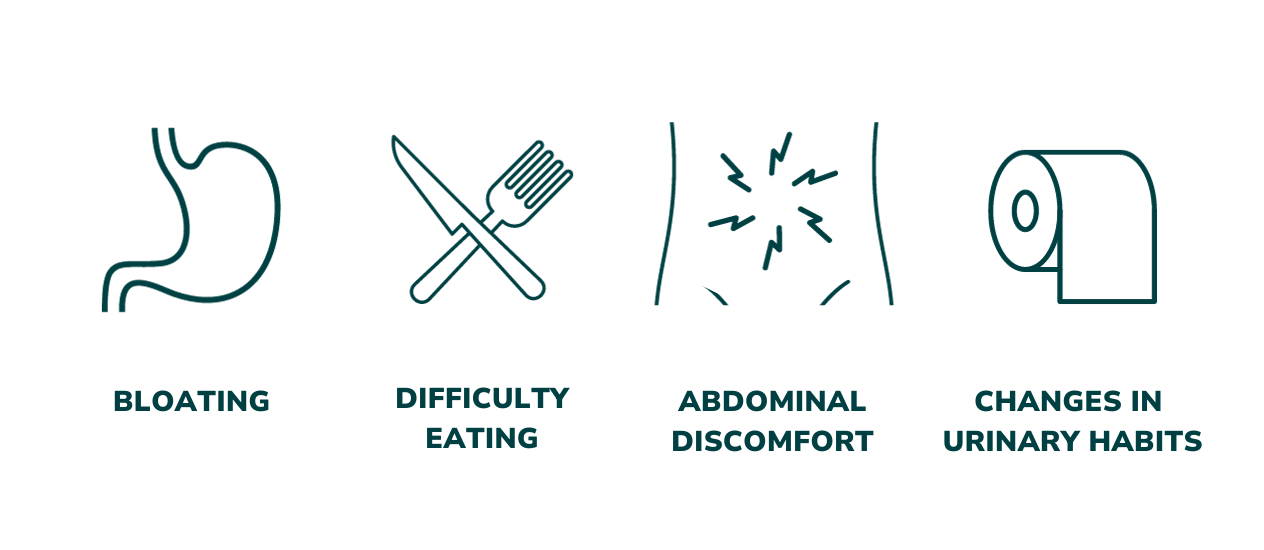Symptoms of ovarian cancer
Ovarian cancer is notoriously difficult to detect. There is no effective screening test for this disease. You know best what’s normal for you and your body.
Some common symptoms of ovarian cancer may include: bloating, abdominal/pelvic pain or discomfort, difficulty eating or feeling full quickly, and urinary changes. Less common symptoms may include: changes to bowel habits, nausea, fatigue, unexplained weight loss, bleeding after menopause, menstrual irregularities, back pain, indigestion, pain with intercourse, and bleeding after sex.

Symptoms of ovarian cancer can include
It is important to speak to your doctor if you notice any symptoms that are new to you and that persist for three weeks or longer.
It is very important to note that these symptoms do not mean that you have ovarian cancer. You are your own best advocate and it is important to seek medical care if you are experiencing any symptoms that are:
- New – they are not normal for you and may have started in the last year
- Persistent – they have been present for more than 3 weeks
- Frequent – you notice the symptoms happen frequently
In many cases of ovarian cancer, no symptoms are experienced.
How to detect ovarian cancer
- There is no screening test for ovarian cancer, and there is no single reliable diagnostic test for ovarian cancer.
- The symptoms are vague and mimic other more common and benign conditions.
- The most common type of ovarian cancer spreads when the cancer cells are still very small, before symptoms even appear. As a result, ovarian cancer is often diagnosed in later stages (Stages 3 and 4) which has a negative effect on survival.
- Many Canadians mistakenly assume that the HPV vaccine prevents ovarian cancer, and that the Pap test detects ovarian cancer. This is incorrect. The HPV vaccine and the Pap test are associated with cervical cancer. Significant global cancer research is underway to develop a reliable screening test to detect ovarian cancer in its early stages. However, at this time, there is not a single test that is sensitive enough to detect ovarian cancer in its earliest stages.
- Transvaginal ultrasound – A narrow probe is inserted into the vagina which emits high-frequency sound waves that bounce off the ovaries and produce echoes that are used to create a picture called a sonogram. Doctors examine the sonogram for echoes that might represent abnormalities.
- Full pelvic exam – The doctor will touch the outside of your abdomen (palpate the abdomen) to feel for masses. Then, with fingers inside the vagina and rectum, try to feel your ovaries from the inside.
- CA125 blood test – This is a blood test that measures a specific protein in the blood called “cancer antigen 125” (CA125). The CA125 blood test is NOT a reliable early detection test for ovarian cancer. For some people, but not all, ovarian cancer may cause a rise in CA125. However, it is very important to note that the CA125 may rise for several reasons that are unrelated to cancer, including menstruation. Therefore, this blood test is only one tool that doctors can use in investigating potential cases of ovarian cancer and must be used in combination with the above tests. It is important to remember that none of these tests are diagnostic tests. Instead, they will provide your doctor with more information. It is very important that you follow up with your doctor if your symptoms persist.
If ovarian cancer is suspected, you should be referred to a gynecologic oncologist for diagnosis through surgical biopsy. Your surgery must be performed by a gynecologic oncologist, as these doctors are specialized in ovarian cancer.
Research has shown that when surgery is performed by a gynecologic oncologist instead of another physician, the patient’s outcomes are improved.
If ovarian cancer is confirmed with surgical biopsy, your medical team will determine the subtype, grade, and stage of the cancer. This information will help you and your medical team in determining the best course of treatment for you.
Ask questions, you are your own best advocate
In all phases of your diagnosis and treatment, discuss the results with your doctor. Ask questions, write down the responses, and ask your doctor to clarify anything you don’t understand. If you can, bring someone with you to your appointments, such as a family member or close friend, to help listen and understand the information you are being provided. You can even ask your doctor if you can audio record the conversation (for example, using your mobile phone), so that you can listen again later if you forget anything.
Be sure to also discuss any relevant risk factors for ovarian cancer with your doctor.
Getting a second opinion
A diagnosis of ovarian cancer may be overwhelming. You should be comfortable with your treatment plan. You may want a second opinion to confirm your doctor's recommendations. It's your right to seek a second opinion.
Depending on where you are during your diagnosis and treatment, either your own family doctor or the gynecologic oncologist can refer you for a second opinion.
Continue learning
Article
Grades of ovarian cancer
The grade of a tumour refers to how abnormal the tumour cells look under a microscope. It is an indicator of how quickly a tumour is likely to grow and spread. The more the cancer cells look like a normal cell, the more they will behave like a normal cell. Knowing the grade of a cancer helps the medical team to determine how effective a certain treatment may be.
Article
Stages of ovarian cancer
Staging is the process of finding out how widespread the cancer is within the body. If the cancer has spread, the stage describes how far it has spread from the ovaries to other parts of the body.
Article
Ovarian cancer risk factors
Everyone born with ovaries has some risk for ovarian cancer. Some people have higher risk than others based on a number of factors.
Canadian Cancer Society (2022). Grading Cancer. Retrieved: website link.
Canadian Cancer Society (2022). Staging ovarian cancer. Retrieved: website link.
Gynecologic Cancer Institute (2022). Ovarian Cancer Prevention. Retrieved: website link.
Mayo Clinic (2022). CA 125 Test. Retrieved: website link.
National Cancer Institute (2022). Prevention. Retrieved: website link.


